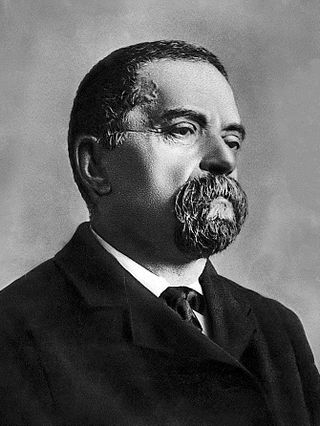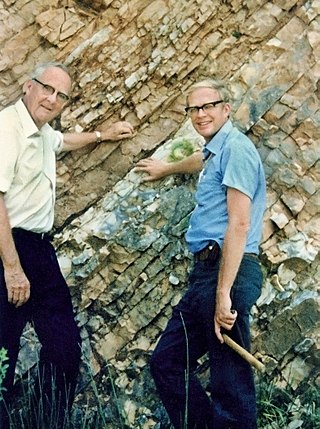Related Research Articles

An impact crater is a circular depression in the surface of a solid astronomical object formed by the hypervelocity impact of a smaller object. In contrast to volcanic craters, which result from explosion or internal collapse, impact craters typically have raised rims and floors that are lower in elevation than the surrounding terrain. Lunar impact craters range from microscopic craters on lunar rocks returned by the Apollo program and small, simple, bowl-shaped depressions in the lunar regolith to large, complex, multi-ringed impact basins. Meteor Crater is a well-known example of a small impact crater on Earth.

Ejnar Hertzsprung was a Danish chemist and astronomer.

Giovanni Virginio Schiaparelli was an Italian astronomer and science historian.

Walter Alvarez is a professor in the Earth and Planetary Science department at the University of California, Berkeley. He is most widely known for the theory that dinosaurs were killed by an asteroid impact, developed in collaboration with his father, Nobel Prize–winning physicist Luis Alvarez.

Karl Theodor Robert Luther, normally published as Robert Luther, was a German astronomer. While working at the Bilk Observatory in Düsseldorf, Germany, he searched for asteroids and discovered 24 of them between 1852 and 1890. Seven times Lalande Prize winner.
Jean Chacornac was a French astronomer and discoverer of a comet and several asteroids.

Johann Palisa was an Austrian astronomer, born in Troppau, Austrian Silesia, now Czech Republic. He was a prolific discoverer of asteroids, discovering 122 in all, from 136 Austria in 1874 to 1073 Gellivara in 1923. Some of his notable discoveries include 153 Hilda, 216 Kleopatra, 243 Ida, 253 Mathilde, 324 Bamberga, and the near-Earth asteroid 719 Albert. Palisa made his discoveries without the aid of photography, and he remains the most successful visual (non-photographic) asteroid discoverer of all time. He was awarded the Valz Prize from the French Academy of Sciences in 1906. The asteroid 914 Palisana, discovered by Max Wolf in 1919, and the lunar crater Palisa were named in his honour.
Grigory Nikolayevich Neujmin was a Georgian–Russian astronomer, native of Tbilisi in Georgia, and a discoverer of numerous minor planets as well as 6 periodic and a hyperbolic comet at the Pulkovo and Simeiz Observatories during the first half of the 20th century.
Eugène Joseph Delporte was a Belgian astronomer born in Genappe.
Pelageya Fedorovna Shajn, née Sannikova, was a Russian astronomer in the Soviet Union, and the first woman credited with the discovery of a minor planet, at the Simeiz Observatory in 1928. Pelageya also discovered numerous variable stars and co-discovered the periodic, Jupiter-family comet 61P/Shajn–Schaldach. She was married to prominent Soviet astronomer Grigory Shajn.

Roxane is an asteroid from the asteroid belt approximately 19 km in diameter. It was discovered by Auguste Charlois from Nice on September 11, 1891. The name was chosen by F. Bidschof, an assistant at the Vienna Observatory, at Charlois' request; Bidschof chose to name it after Roxana, the wife of Alexander the Great, and at first used the spelling "Roxana".
Christopher Aikman is a Canadian astrophysicist who spent most of his career at the Dominion Astrophysical Observatory, National Research Council Canada in Saanich, British Columbia, Canada.

Robert Sinclair Dietz was a scientist with the United States Coast and Geodetic Survey. Dietz, born in Westfield, New Jersey, was a marine geologist, geophysicist and oceanographer who conducted pioneering research along with Harry Hammond Hess concerning seafloor spreading, published as early as 1960–1961. While at the Scripps Institution of Oceanography he observed the nature of the Emperor chain of seamounts that extended from the northwest end of the Hawaiian Island–Midway chain and speculated over lunch with Robert Fisher in 1953 that something must be carrying these old volcanic mountains northward like a conveyor belt.

The Lac Wiyâshâkimî, also called the Clearwater Lakes in English and Allait Qasigialingat by the Inuit, are a pair of annular lakes and possible impact craters on the Canadian Shield in Quebec, Canada, near Hudson Bay.
1365 Henyey, provisional designation 1928 RK, is a stony Florian asteroid from the inner regions of the asteroid belt, approximately 11 kilometers in diameter. It was discovered by German astronomer Max Wolf at Heidelberg Observatory in southern Germany on 9 September 1928, and named for American astronomer Louis Henyey.

9951 Tyrannosaurus, provisional designation 1990 VK5, is a stony Vestian asteroid from the inner regions of the asteroid belt, approximately 17 kilometers in diameter. It was discovered on 15 November 1990, by Belgian astronomer Eric Elst at ESO's La Silla Observatory in northern Chile. It was named after Tyrannosaurus, a genus of dinosaurs.
4340 Dence, provisional designation 1986 JZ, is a background or Phocaea asteroid from the inner regions of the asteroid belt, approximately 8 kilometers in diameter. It was discovered on 4 May 1986, by American astronomer Carolyn Shoemaker at the Palomar Observatory in California. The S-type asteroid has a rotation period of 7.5 hours. It was named after Canadian geologist Michael R. Dence.
1658 Innes, provisional designation 1953 NA, is a rare-type asteroid from the middle region of the asteroid belt, approximately 15 kilometers in diameter. It was named after Robert T. A. Innes.
Robert Phillip Sharp was an American geomorphologist and expert on the geological surfaces of the Earth and the planet Mars. Sharp served as the chairman of the Division of Geological Sciences at California Institute of Technology (Caltech) from 1952 to 1968. He built the modern department and especially recruited new faculty in geochemistry, tectonic geomorphology, planetary science, and field geology.
Tetsuya Fujii is a Japanese amateur astronomer and prolific discoverer of minor planets.
References
- ↑ "Order of Canada Recipients" . Retrieved November 14, 2020.
- ↑ "Mr. Michael Robert Dence". Governor General of Canada. Retrieved 14 January 2023.
- ↑ "(4340) Dence". (4340) Dence In: Dictionary of Minor Planet Names. Springer. 2003. p. 372. doi:10.1007/978-3-540-29925-7_4292. ISBN 978-3-540-29925-7.
- 1 2 R. S. Dietz (September 1988). "Barringer Medal citation for Michael R. Dence". Meteoritics. 23 (3): 317–317. Bibcode:1988Metic..23..317D. ISSN 0026-1114. Wikidata Q101634288.
- ↑ Romaniuk, Colleen (9 July 2021). "It's been 50 years since NASA's Apollo 16 astronauts walked on Sudbury". The Sudbury Star. Retrieved 4 February 2024.
- ↑ "4340 Dence (1986 JZ)". Minor Planet Center. Retrieved 3 May 2018.